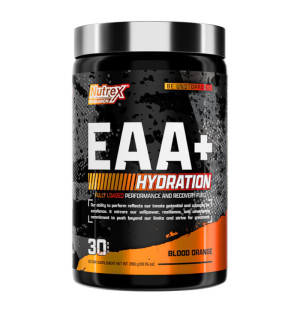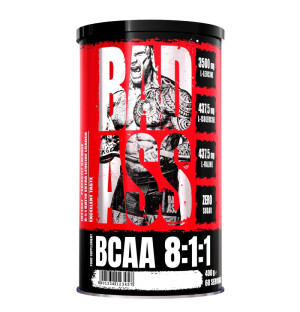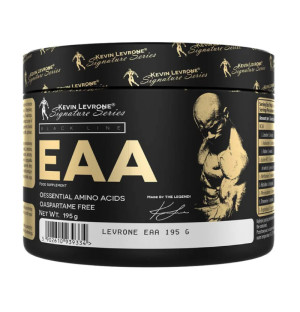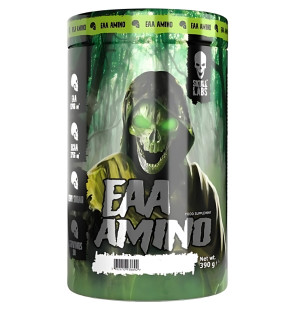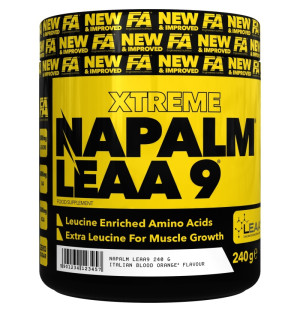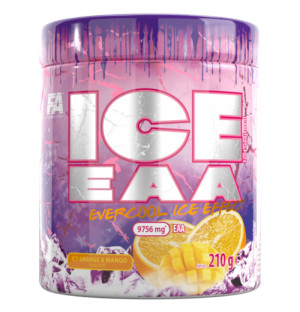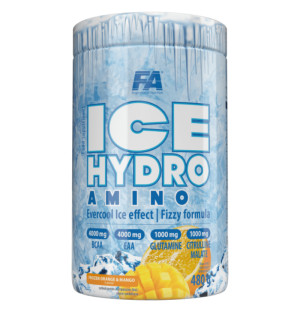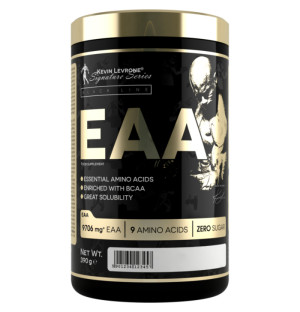Exogenous amino acids EAA
Essential Amino Acids (EAA) are a group of eight essential amino acids that the human body cannot synthesize on its own. They must be supplied externally through diet and supplementation. They are fundamental building blocks of proteins and are crucial for proper body function. For athletes and physically active individuals, EAA supplements are excellent support for muscle growth, faster recovery, and improved training performance.
What Are Essential Amino Acids (EAA)?
Essential amino acids are eight indispensable amino acids that the body must obtain from external sources. Unlike non-essential amino acids, which the body can produce, EAAs are the basic building blocks of all proteins in the body. Without an adequate supply of EAAs, proper protein synthesis, tissue regeneration, and optimal immune function are not possible.
The eight essential amino acids are:
- Leucine – the most important activator of the mTOR pathway responsible for muscle protein synthesis; it regulates glucose levels and supports growth hormone production
- Isoleucine – protects against muscle catabolism during exercise, aids in recovery, involved in hemoglobin production and blood sugar regulation
- Valine – supports energy production in muscle cells, tissue repair, and nitrogen balance
- Lysine – essential for collagen and elastin synthesis, aids calcium absorption, and supports hormone and enzyme production
- Methionine – a powerful antioxidant, supports liver detoxification, involved in fat metabolism and creatine synthesis
- Phenylalanine – precursor to neurotransmitters (dopamine, norepinephrine), has analgesic effects, and improves focus
- Threonine – part of structural proteins in skin and connective tissue, supports immune function and lipid metabolism
- Tryptophan – precursor to serotonin and melatonin, regulates mood, sleep, and appetite, increases pain tolerance during exercise
How EAA Work in the Body
After ingestion, EAAs are quickly absorbed in the small intestine and enter the bloodstream directly, bypassing the liver. They reach peak blood concentration within 30–60 minutes of consumption, making them ideal for peri-workout supplementation.
In muscle cells, EAAs activate the key anabolic pathway known as mTOR (mechanistic Target of Rapamycin), the main regulator of protein synthesis. Leucine, in particular, acts as a "molecular switch" to initiate protein-building processes. Studies show that proper EAA intake can boost muscle protein synthesis by up to 50–100%.
Natural Sources of EAAs
While supplements provide a concentrated form of EAAs, it’s worth knowing the natural sources:
Animal sources (complete proteins):
- Meat: beef, pork, poultry, game
- Fish and seafood: salmon, tuna, shrimp, trout
- Dairy products: cheese, yogurt, cottage cheese, milk
- Chicken eggs – contain the highest-quality protein with a complete amino acid profile
Plant sources (require combining):
- Legumes: soy, lentils, beans, chickpeas
- Nuts and seeds: almonds, sunflower seeds, chia, flax
- Whole grains: quinoa, amaranth, buckwheat
- Vegetables: spinach, broccoli, asparagus
Why Supplementation Helps: Most plant sources lack the full EAA profile or contain low levels of key amino acids. Supplements provide optimal ratios of all eight EAAs in an easily absorbable form.
Effects and Benefits of EAA Supplementation
For muscles and recovery: ✅ Faster recovery – reduced tissue repair time post-workout
✅ Muscle growth – supports anabolic processes and protein synthesis
✅ Anti-catabolic effects – prevents muscle protein breakdown
✅ Increased strength and endurance – improves workout performance
For metabolism and health: ✅ Hormonal support – stimulates growth hormone and insulin production
✅ Improved mood – increased serotonin ("happy hormone") synthesis
✅ Enhanced immunity – supports immune system functions
✅ Hydration optimization – electrolyte products help maintain fluid balance
Who Should Take EAAs?
EAA supplements are especially recommended for:
Athletes and active individuals – high training intensity increases the need for essential amino acids. EAAs support recovery and muscle building.
Vegans and vegetarians – plant-based diets often lack complete proteins containing all essential amino acids.
People on calorie-restricted diets – during fat loss, EAAs help preserve muscle mass.
Seniors – aging reduces amino acid absorption and utilization; supplementation supports muscle maintenance.
Safety and Optimal Dosage
Basic dosage: 7–15g daily, depending on body weight, training intensity, and goals. Individuals weighing 70–80 kg should use 10–12g, while heavier athletes may increase to 15g.
Best times to supplement:
- 30 minutes before workout – ensures availability during exercise
- Immediately after workout – supports the recovery process
- Between meals – maintains a positive nitrogen balance
- Before bed (tryptophan-containing products) – supports nighttime recovery
Combining with other supplements: ✅ With creatine – synergistic effects on strength and muscle growth
✅ With vitamin B6 – improves amino acid metabolism
✅ With magnesium – supports muscle and nerve function
✅ With beta-alanine – increases muscular endurance
What to avoid: ❌ Consuming with high fiber (may reduce absorption)
❌ Combining with alcohol (disrupts amino acid metabolism)
❌ Exceeding recommended dose (may cause stomach discomfort)
Safety: EAAs are natural components found in food. When taken as recommended, they are completely safe. Possible side effects may include temporary stomach discomfort if single doses are too high.
Contraindications: People with kidney disease, amino acid metabolism disorders, or those taking antidepressants should consult a doctor before supplementing.
EAA vs BCAA – Key Differences
BCAAs are just three branched-chain amino acids (leucine, isoleucine, valine), which are part of the larger EAA group. EAAs contain all 8 essential amino acids, offering more comprehensive support for protein synthesis.
While BCAAs mainly focus on anti-catabolic effects, EAAs provide the full spectrum of building blocks necessary for the creation of new muscle proteins.
Frequently Asked Questions
When is the best time to take EAAs?
Ideally, 30 minutes before and immediately after training. They can also be taken between meals to support protein synthesis.
Can EAAs be combined with other supplements?
Yes, EAAs pair well with creatine, vitamins, and minerals. Avoid taking them with large amounts of fiber.
How long should I take EAAs to see results?
Initial effects such as better recovery may be noticed within 1–2 weeks. Significant muscle gain is usually visible after 4–8 weeks of consistent use.
Do EAAs replace protein powder?
No, EAAs complement a protein-rich diet. Complete proteins also provide non-essential amino acids and other nutrients.
Do EAAs help with fat loss?
EAAs help maintain muscle during a calorie deficit, which boosts resting metabolism and supports fat burning. Leucine may also enhance fatty acid oxidation.
Why Buy from GymHub.pro?
At GymHub.pro, you’ll find only original products from trusted brands like Nutrex, Raw Nutrition, NAPALM, and LEVRONE. We offer competitive prices, fast delivery, and expert advice on choosing the right supplement. Our EAA products guarantee the highest quality ingredients and effectiveness, as proven by thousands of satisfied customers.
Legal Disclaimer
The information provided is for educational purposes and does not constitute medical advice. Dietary supplements are not a substitute for a varied diet and a healthy lifestyle. Consult your doctor before starting any supplementation, especially in the case of chronic illnesses, pregnancy, or breastfeeding. These products are not intended to diagnose, treat, or prevent any disease.

